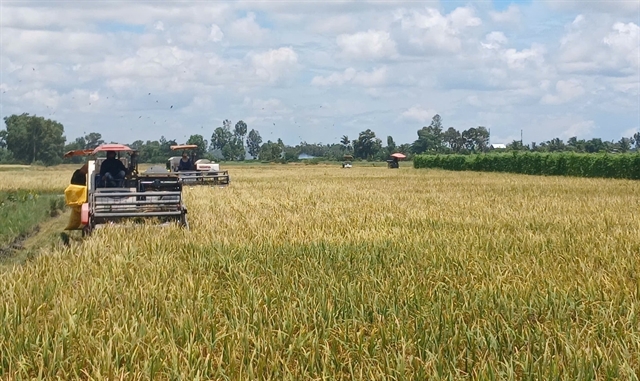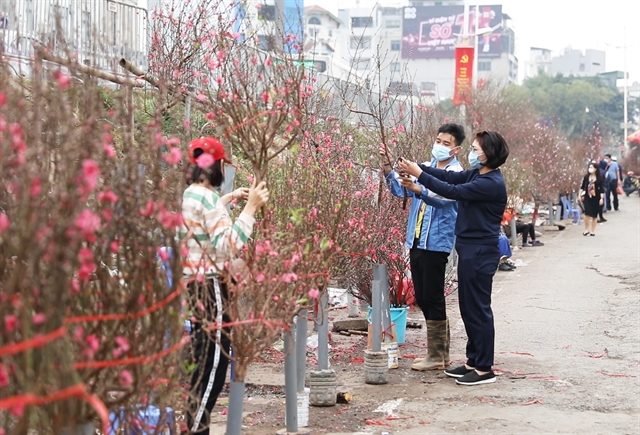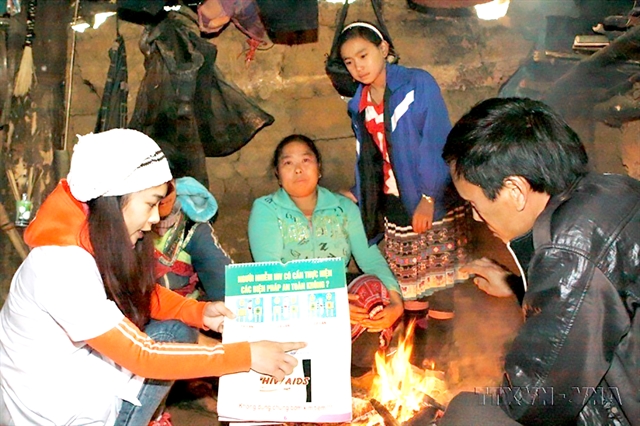 Economy
Economy

Bảo Hoa, Nguyễn Linh Chi & Lê Hương
HÀ NỘI — Prices of peach blossoms in Hà Nội have dropped drastically since the latest COVID-19 outbreak at the end of January.
As the Tết (Lunar New Year) holiday approaches people in the capital city flock to Quảng An market in Tây Hồ District where a variety of the holiday trees are sold.
Although the market still looks busy, peach sellers said the discovery of new community infections on January 28 and those that followed have taken a toll on sales.
Lê Thị Bé, 55, who buys peach branches from farmers to sell at the market, said: “Before the COVID-19 outbreak they were selling very fast. But since the outbreak sales have slowed down. Very slow. And the trees became much cheaper too.
“If we buy a tree from the peach gardens for VNĐ1 million (US$43), we can only sell it at about VNĐ500,000 ($22) here. People said they don’t have money because of COVID.”
Vendors like Bé sell all types of peach trees – round, tilted, specially shaped.

|
| Peach blossom branches of all shapes are sold at Quảng An Flower Market in Hà Nội's Tây Hồ District. Big branches were sold at VNĐ1-2 million before the outbreak. VNS Photos Bảo Hoa |
The most expensive ones are around VNĐ2 million, and the least expensive VNĐ200,000, she said.
Nguyễn Trường Sơn, 20, whose family grows and sells the trees, added: “Before the outbreak the prices were very high. Small branches could be sold at VNĐ300,000-400,000, and big ones at VNĐ1-2 million. But since the outbreak and all the isolations were implemented, prices have dropped drastically.
“Normally we can sell 15-20 branches a day, but because of the outbreak, now on a good day we can only sell from eight to 10.”
Buyers have also noticed the changes in prices.
Trịnh Tuấn Anh, an office worker from Bắc Ninh Province, said he found the trees about 30 per cent cheaper than last year.
“I do find them cheaper this year. One that would have cost VNĐ1.5 million last year costs only VNĐ1 million this year,” he said.
“I guess that’s because of the pandemic, which makes it more difficult to travel, and people also don’t want to spend a lot of money.
“But for me that’s good, because now I can get what I want at a reasonable price.”

|
| A shopper browses small branches of peach blossoms at Quảng An market, which are sold at VNĐ100,000-200,000. |
The pandemic is also affecting the traditional holiday and how people prepare for it.
“Because of the pandemic I feel like this market is a little less vibrant than previous years,” said Phạm Hồng Ngọc, an office worker from Hà Nội’s outlying district of Hà Đông.
“My husband and I planned to buy a lot of flowers to decorate our house for Tết. But because of the outbreak, we have decided to buy just enough, because people won’t be able to visit each other’s houses like every year anyway.”
Peach blossoms are also being sold in the Old Quarter during the Hàng Lược Tết Flower Market, a traditional event held only once a year a week before the Lunar New Year Eve.
Sellers here are also experiencing a sales drop due to COVID-19.
Phạm Văn Hạnh, 45, from Phú Thượng Ward, Tây Hồ District said the prices for flowers and bonsai halved this year compared to last year.
“There are fewer customers so I have to sell at lower prices,” he said.
“A small branch of peach blossom which costs VNĐ150,000-200,000 last year is now sold at VNĐ100,000 only. But there are still not many people willing to buy. The pandemic and economic degradation are having a major effect on us.”
Trương Mai Phương, 31, said she is seeing the lowest number of customers this year since she started selling flowers ten years ago.
“I hope the authorities can control the pandemic so that people can enjoy the Lunar New Year,” Phương said.
Việt Nam reported two community infections on January 28 in Hải Dương and Quảng Ninh provinces, the first local transmissions for nearly two months.
As of yesterday morning the country’s caseload stood at 1,957, with 1,465 having recovered from the disease. — VNS




